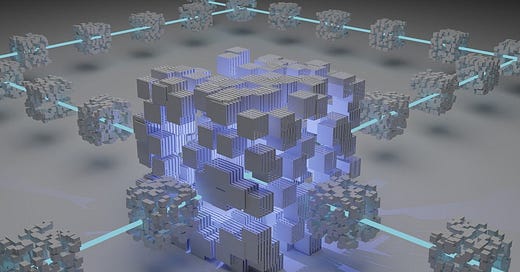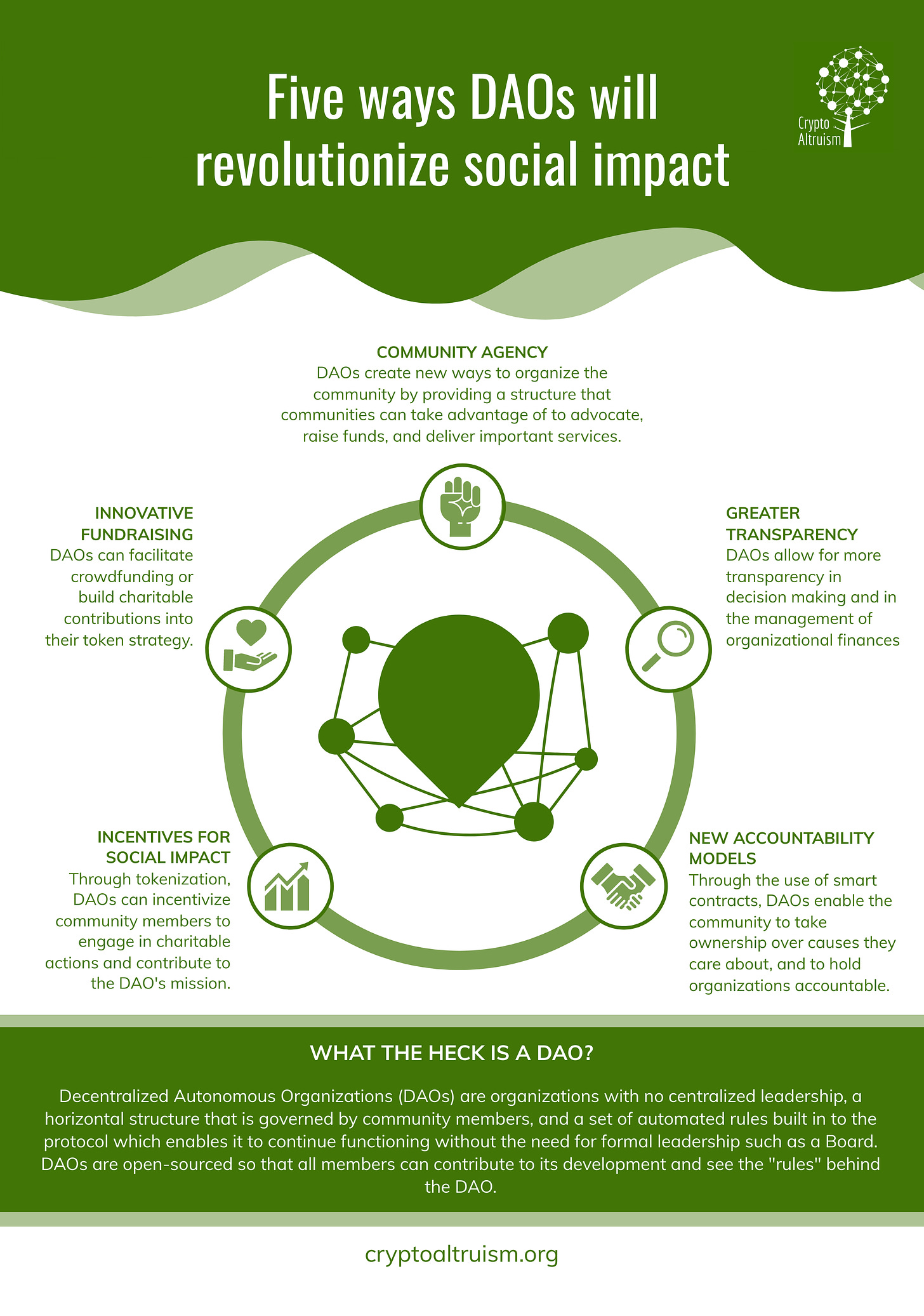DAOs - Disrupting the Charity Model
How Decentralized Autonomous Organizations could shake up the antiquated charity world
DAOs are set to revolutionize social impact. In some of today’s charitable organizations, less than 10% of donations go towards a charity’s stated purpose! A significant amount goes towards unnecessary administrative costs and overhead or does not get spent effectively.
Additionally, some cases of fraud and misspending by charities have left a bitter taste in donor’s mouths. These cases impact the sector as a whole by breaking down trust, negatively impacting honest, high impact charitable organizations.
With DAOs, there’s potential to flip this model on its head.
DAOs enable:
Transparency - with transactions natively occurring on public blockchains for everyone to see, it’s much easier to follow the money and see what is being spent where. It also allows donors to see what percentage of their donation is going to middlemen, such as third-party payment processors.
Efficiency - because community members are more empowered to volunteer and help make decisions with the additional agency they get through ‘owning’ or directly influencing the cause, and have opportunities to earn non-monetary (or monetary) incentives (e.g., NFTs, governance tokens, reputation-based tokens, etc.).
Accountability - the DAO is accountable to its members and decisions can be both transparently monitored as well as enforced by smart contracts ex-ante and/or resolved post-facto through decentralized dispute resolution.
These three pillars enable the creation of a new generation of cause-driven organizations to proliferate. We can imagine a world where operating as a DAO becomes a powerful means to bring about change, and do so more efficiently than many traditional charitable organizations can claim.
One example is The Peace DAO, which is radically reducing overhead and maximizing impact through humanitarian relief in war-torn Ukraine, including evacuations and supplies. The Peace DAO has been able to directly affect thousands of lives without spending any capital on expenses unrelated to directly funding on-the-ground causes.
Will DAOs Replace Traditional Charities?
However, the question remains—what does this mean for today’s non-profits and charities? Will there be a space for them in this new Web3 world if DAOs are successful in realizing their potential?
In times of disruption, a couple things can happen.
The old model ceases to exist (think VHS tapes and DVDs)
The old model still exists but the industry innovates and improves to meet new customer expectations (think banks responding to FinTechs)
DAOs Will Force The Nonprofit Sector To Change
With the latter disruption model being likely, Web2 orgs may innovate, with some even potentially making use of web3 tools to supplement their traditional operations.
If DAOs are able to radically improve the efficiency of solving problems and creating desired impact through this new model, this could definitely change where funding dollars go. Funding dollars moving away from inefficient models and going towards more efficient ones will definitely provide clear incentives for traditional charitable organizations to make some changes. When you add innovative new fundraising mechanisms, such as quadratic funding to the equation, it also helps stretch the impact of each donor dollar.
Large charities and NGOs that are more susceptible to these types of problems are generally slow and bureaucratic organizations and have limited incentives to change. It’s also important to recognize that the non-profit sector tends to be risk-averse, often out of necessity due to the traditional structures governing NGOs, making it difficult to innovate and enact significant change even if they want to.
This is why disruption is needed, it forces industries to improve or face losing their customers (in this case, the support of their donors). We likely have not seen a ton of change in the nonprofit sector because there has been a lack of force pushing fundamentally disruptive ideas into the industry for a long time.
If DAOs are going to be that disruptive change, then other organizations will need to figure out how to keep pace with them.
How Charitable Organizations Can Innovate
Innovating doesn’t mean that every organization has to become a DAO. Besides that not being very realistic, it ignores some other potential paths which have much lower friction.
Traditional orgs working with or participating in DAOs
Organizations can leverage DAOs as a means to increase their impact potential. An organization could, for example:
Donate to a DAO as a means to inherit new distribution channels, if the DAO is able to put the capital to work more efficiently or in ways that the organization couldn’t
Contribute to a DAO with non-monetary value, such as research, sharing distribution channels, or other activities that support the DAO
Partner with a DAO on a shared project, or as a recipient of funding from the DAO, with all funds being tracked on-chain to ensure accountability and transparency.
The Peace DAO, for example, is partnering with larger charitable organizations to help them attain higher impact per dollar on their spend, using them as a channel. It’s a win-win since the DAO has connections to verified volunteer groups on the ground in Ukraine that need funds and these organizations have funds that need to be deployed with a mandate for impact.
Traditional orgs creating DAOs
Organizations may also decide to create DAOs for specific purposes that help them achieve their mission. This doesn’t necessarily mean turning their whole organization into a DAO model, something that’s probably very hard to do for most orgs and may not have very good results.
However, it could mean that they use a DAO to get broader industry stakeholder participation and build or greater leverage a community that they have to take action around a cause.
Conclusion
It’s clear that DAOs have incredible potential to positively disrupt the non-profit sector, bringing greater transparency, accountability, and efficiency to traditional charitable organizations. However, this change will not happen overnight.
Many underestimate how massive the non-profit sector is. The larger an institution tends to be, the longer change will take. In fact, there are roughly 1.8 million non-profit organizations in the US alone. That being said, change will be a slow and steady process, with each non-profit approaching this issue at their own pace and donors demanding better accountability and transparency to the charities they support.
One thing, however, is for certain. With aging donor demographics, the impending largest transfer of wealth from one generation to another and a greater importance being placed on transparency by emerging generations, non-profits need to innovate to stay relevant, survive, and ultimately, to thrive. DAOs present a compelling opportunity for organizations to innovate, and one that NGOs all over the world ought to be considering.
This article was co-authored by Drew Simon from Crypto Altruism - follow them on Twitter at @Crypto_Altruism






